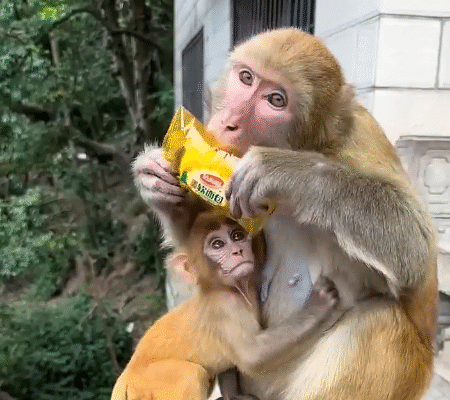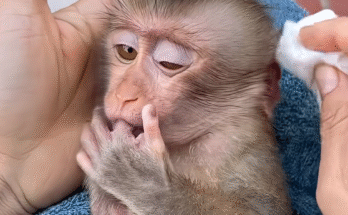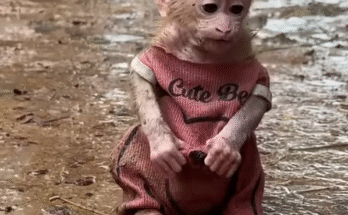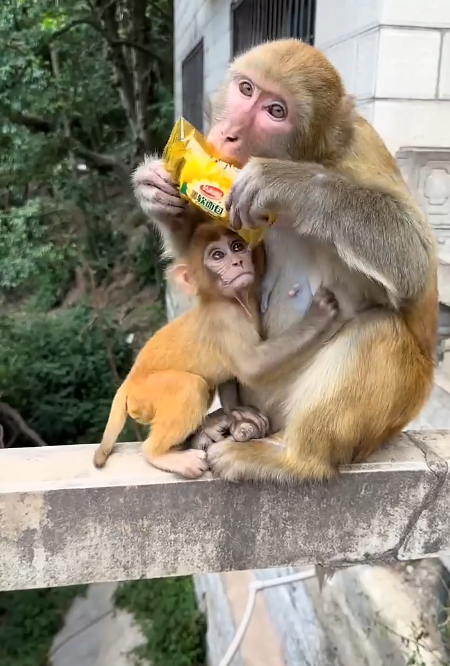
In the heart of a dense green forest, not far from a bustling little village, there lived a troop of monkeys that had long captured the attention of the people nearby. Among them was one very special figure: a mother monkey, known simply to the villagers as Okay Monkey. Her story was whispered among children, shared by elders, and even captured on phones by curious visitors. She wasn’t called Okay Monkey because she was ordinary — in fact, it was quite the opposite. The name came from her calm, resilient, and balanced way of living, especially when life threw challenges her way.
A Mother in the Wild
The monkey mother lived high in the trees, but unlike many in her troop, she often ventured close to the village. She had two babies clinging to her side, their tiny fingers wrapping tightly around her fur as if she were their entire world. In many ways, she was.
Life in the wild is not easy for a mother. She had to protect her little ones from snakes, stray dogs, and even rival monkeys who sometimes grew aggressive over food or territory. But every time danger appeared, the villagers noticed something remarkable: she never panicked.
If a dog barked too close, she stood tall, shielding her babies with her arms, glaring until the dog backed away. If other monkeys tried to snatch her food, she shared calmly or pulled her children closer, waiting until the threat passed. Where other animals might screech in fear or lash out wildly, this mother always seemed to carry herself with dignity. That is why people began saying, “This monkey mother is okay monkey. She can handle everything.”
The Day of the Storm
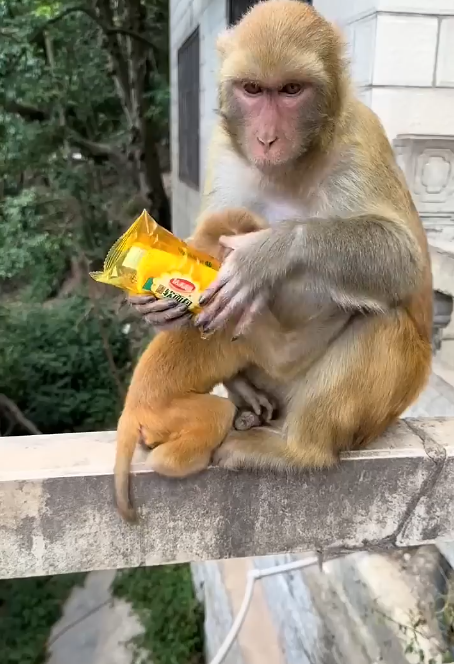
One unforgettable evening, dark clouds rolled over the forest. Thunder rumbled like a drumbeat, and rain began to pour in heavy sheets. The monkeys scrambled in all directions, some screeching, some huddling under leaves, others fighting for the driest branches.
But not the Okay Monkey. She calmly gathered her two babies, climbing to a thick, sturdy branch. There, she wrapped her arms around them, using her body as a shield against the rain and wind. For hours she sat there, soaked and shivering, but never loosening her hold.
When the storm finally ended, and the morning sun filtered through the dripping leaves, the villagers saw her again — wet but calm, still holding her babies close. The sight moved many hearts. “This monkey mother is more than okay,” one villager said softly. “She is strong.”
A Daily Struggle for Food
Every day brought new challenges. The mother had to climb, forage, and sometimes sneak near the village market to find enough food for her little family. Bananas, mangoes, leftover rice — whatever she could gather, she shared first with her babies.
Sometimes, she went hungry herself. Villagers noticed her pushing bits of fruit into her children’s mouths while chewing nothing herself. Yet she never seemed bitter. Her eyes, though tired, always held warmth when she looked at her young ones.
One afternoon, a vendor accidentally dropped a bag of peanuts near the forest edge. Several monkeys rushed at it, screeching and fighting to grab the most. But the mother monkey simply waited, her babies clinging tightly. When the scuffle ended, she quietly picked up what little was left, calmly splitting the peanuts in half for her children.
“See?” said a child watching nearby. “This monkey mother is okay monkey. She doesn’t fight. She just takes care of her babies.”
The Time of Danger
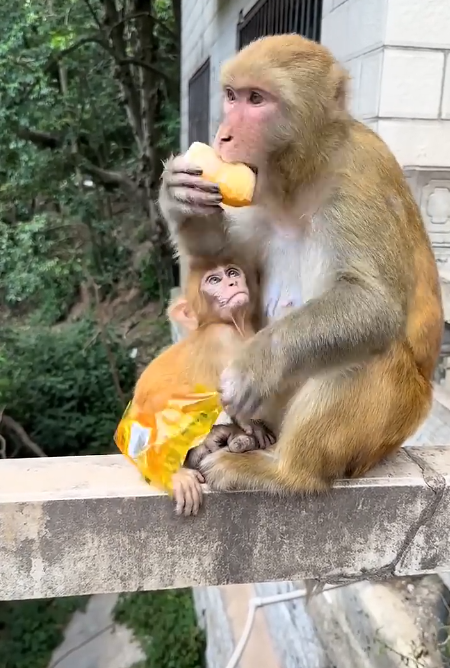
Not all days were peaceful. One summer, food in the forest grew scarce, and the troop often wandered into the village. One hungry evening, a group of monkeys tried to steal from a fruit seller’s stall. The seller grew angry, chasing them away with a stick. The monkeys scattered in fear, but the mother monkey stayed back because one of her babies had slipped and fallen to the ground.
The baby screamed in fright, and the crowd gasped, fearing the worst. But in a flash, the mother monkey rushed forward, scooped her little one into her arms, and leapt onto a roof. She did not retaliate, did not screech, did not bite. She only held her child tightly, patting its back as though saying, “It’s okay. You are safe now.”
That moment spread quickly in the village. People said the way she comforted her baby looked almost human. Videos of her gentle embrace circulated, earning her admiration far beyond the forest edge.
A Symbol of Motherhood
Over time, the monkey mother became more than just another animal to the villagers. She became a symbol of motherhood itself — of patience, sacrifice, and resilience. Mothers in the village often pointed her out to their children, saying, “Look how she cares for her babies. That’s what love looks like.”
Even children began to copy her gestures in play, pretending to cradle dolls and calling themselves Okay Monkey Mama. The villagers noticed that whenever the mother monkey was around, children grew quiet, watching her with wide eyes. There was something about her calmness that touched everyone.
The Baby’s First Steps
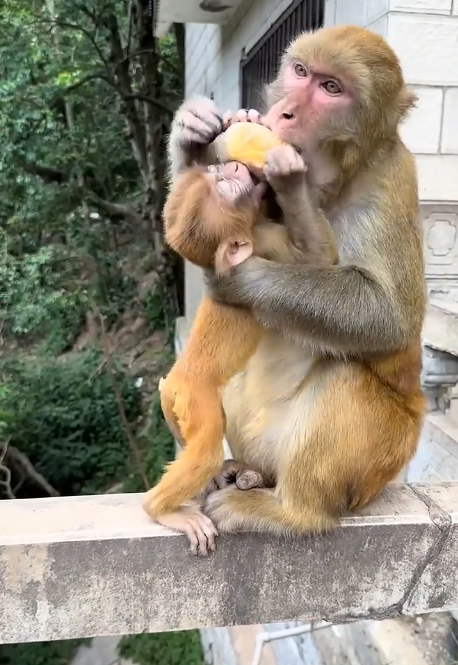
One particularly heartwarming day, one of her babies tried to walk on its own. Still wobbly, it stumbled across a tree branch, nearly losing balance. The mother watched closely, her arms ready to catch. When the little one slipped, she steadied it with a gentle nudge, encouraging rather than scolding.
The baby tried again and again, each time wobbling, each time supported by its mother’s calm presence. Finally, it managed a few steady steps on the branch. The villagers who saw this clapped and cheered as though a human toddler had taken its first steps. The mother monkey simply pulled her baby close, licking its fur proudly.
“That monkey mother,” one villager said with a smile, “she is not just okay. She is wonderful.”
A Lesson for Humans
Though she was just one mother in a forest full of animals, her story grew larger than life. The villagers learned patience by watching her. They learned that strength does not always mean aggression, but sometimes quiet endurance. They learned that love is shown most clearly in sacrifice, in giving up one’s comfort for the sake of another.
Some even believed she carried a blessing — that watching her care for her babies brought good fortune. Others said she was a reminder from nature that motherhood, in all its forms, is sacred.
Conclusion
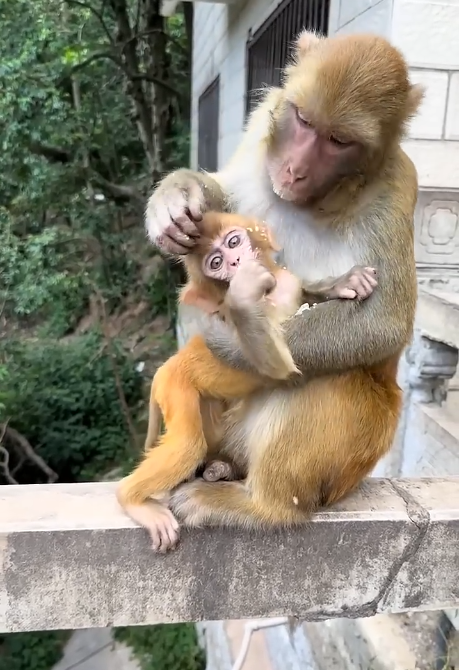
“This monkey mother is okay monkey” became more than a simple phrase. It became a saying in the village — a way of describing someone who could face hardship with calmness, who could protect others with quiet strength, and who could love without expecting anything in return.
Generations of children grew up hearing her story, pointing to the forest trees and asking their parents to show them where Okay Monkey once lived. Even after she was gone, her legacy lingered — a legacy not of fame or fortune, but of the simple, powerful truth that love, especially a mother’s love, is what makes everything “okay.”
And so, in that small corner of the world, whenever a mother was seen cradling her child, or when someone faced difficulties with patience, the villagers would smile and say once more, “This monkey mother is okay monkey.”
